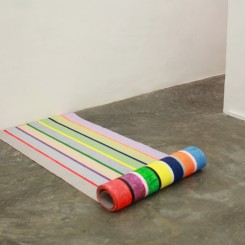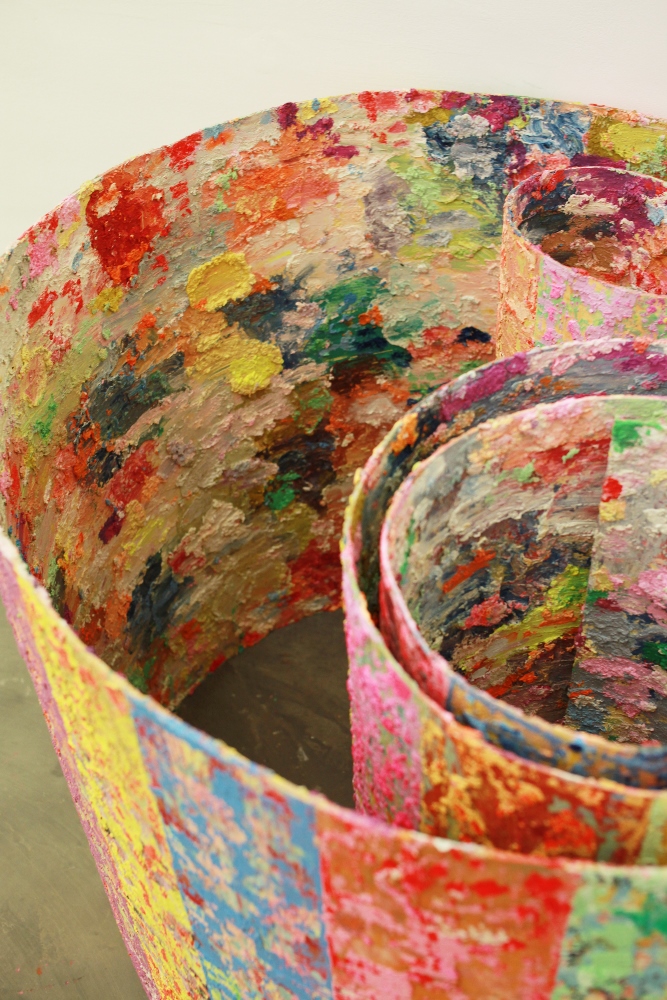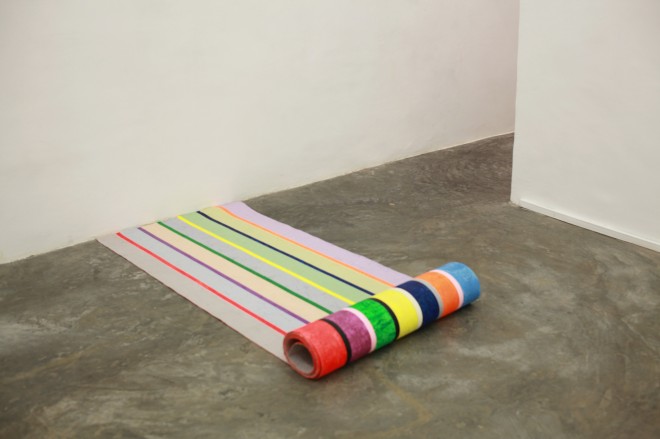“Postpostive: Freaky You Are Always”: solo exhibition by Mit Jai Inn
SA SA BASSAC (2nd Floor, 18 Sothearos Blvd., PO Box 2181 Phnom Penh 3, Cambodia) Apr 3–May 11, 2014
“Words kill,” says Mit Jai Inn. A widely respected and hugely influential yet seldom exhibited senior Thai artist, he is startlingly articulate when discussing such diverse topics as transcendental meditation or party-political impasses. Yet Jai Inn refuses—or is unable—to speak directly about “Postpostive: Freaky You Are Always”, his first solo exhibition in Cambodia. Presented at SA SA BASSAC in Phnom Penh, its experiential effects are indeed difficult to convey in words. Despite consisting of just five works, the exhibition transforms the space into an immersive environment of tactility, color and playful ambiguity.
In the center of the all-white room, “Untitled (Wall Work)” (2012–2014), hangs from a large ceiling beam. At 400 x 300 cm, the work allows exactly one meter on each side for viewers to pass through. Created site-specifically, the work bifurcates the space. The effect is dramatic, yet also gentle: the canvas sways slightly as viewers pass by. Upon entering the gallery, visitors are confronted with horizontal stripes that alternate between primary colors and pastel hues that the artist smilingly calls “freaky,” hovering as they do between the natural and the chemical. The reverse of the piece is a field of roughly round forms, in the same mix of colors. It is evident that the circular shapes are made with a mix of horizontal knife-strokes and staccato dabs of impasto oil. Each circle is approximately the size of the artist’s hand, and overlaid with a brilliant white to a degree that varies gradually over the surface area. As well as recalling some kind of airy natural scene, these features remind us of the artist’s physical movement across the canvas.
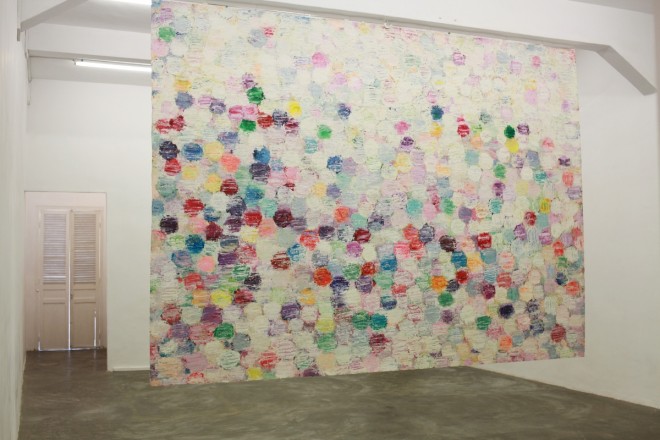
Mit Jai Inn, “Untitled (Wall Work)”, oil on canvas, 2-sided, 300 x 400 cm, 2013-14 (courtesy of the artist and SA SA BASSAC)
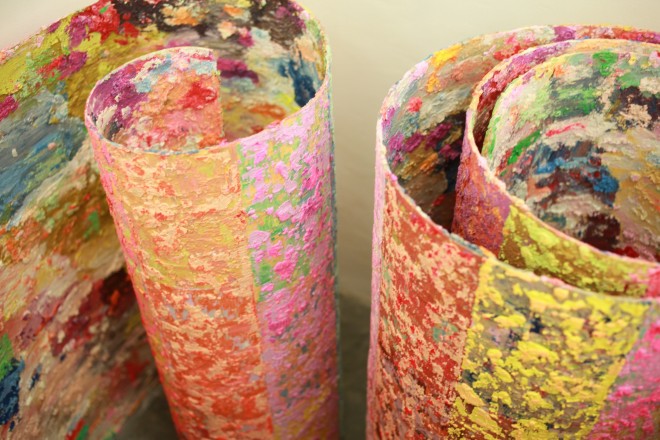
Mit Jai Inn, “Untitled (Scroll)”, oil on canvas, 2-sided, 86.5 x 565 cm, 2014 (courtesy of the artist and SA SA BASSAC)
It is not only “Untitled (Wall Work)” that is painted on two sides. Four works named “Untitled (Scroll)” (2014), two of them 60 x 350cm and two 86.5 x 565cm, also boast stripes on one side, and on the reverse (in the case of the smaller works) long, horizontally perpendicular stripes or (in one larger work) a crusty color-field. These Untitled (Scroll) works—some made with two layers of canvas glued together—are rigid enough to stand upright on the floor, yet flexible enough to be wound and unwound, stretched and loosened. Their placement in the gallery will be reconfigured numerous times over the course of the exhibition. This dynamic display has the effect of decentering visitors’ “knowledge” of the work. Instead, the spatial “experience” in the moment of viewing is playfully foregrounded. To see the two sides of each work, viewers must crouch down, crane their necks and move back and forth in the echoing room. Although Jai Inn calls his practice “painting,” the works are three-dimensional and sculptural. Through the intensity of reflected color they transmit, and in the manner in which they alter the movement of viewers through the gallery environment, these works transform the entire space of SA SA BASSAC.
Jai Inn permits visitors to touch his works; indeed, he encourages it. Children are invited to peel off flakes and chunks of super-textured paint, or to enter the spiral folds of the three Untitled (Scroll) works. Adults are urged to stand at the very edge of the hanging “Untitled (Wall Work)”, gently shaking the canvas while pressing their nose to its rough edge; the effect is a shimmering flicker between stripes and splotches—a mesmerizing optical trick.
Needing a break from all this ocular and bodily immersion in color (not to mention the strong smell of linseed oil), viewers may retreat to the small reading room that adjoins the SA SA BASSAC gallery. Here, though, they will encounter “Postpositive Freaky Nail Bar”, with complementary shades of nail enamel offered for DIY use on weekdays, or “full service” (by a transgendered manicurist, if you’re lucky) on weekends. This exhibition is relentless in its playfulness.
That Jai Inn invites and even insists on the active bodily engagement of viewers is just one way in which “Postpostive: Freaky You Are Always” can be seen as an extension of the artist’s two decades of often participatory practice. For this and all other exhibitions, Jai Inn devolves the responsibility for titling to the hosting gallery or curator. Even the placement of the works in the exhibition space is a collaborative process. In the gallery catalogue, “Postpositive” is explained in part as a reference to the artist’s “ambiguous sense of time and state of being,” while “Freaky You Are Always” is a line from Jai Inn’s correspondence with the gallery. The title and text can thus be seen as a creative continuation in words of the artist’s playful proposals in space.
The catalogue confirms that the artist’s “solitary adventures in perception have relational intentions,” noting that he was a co-founder of the 1992 “Chiang Mai Social Installation”, a foundational participatory project revered within Thailand as a forerunner to Rirkrit Tiravanija’s better known “relational” works, including “The Land Foundation” (collaboratively founded 1998, also in Chiang Mai). For the “Chiang Mai Social Installation”, Jai Inn gave away thousands of small double-sided paintings. The participatory impulse in Thailand in the 1990s fused post-conceptual art theory with an arguably Buddhist-influenced communal generosity.
Jai Inn is, as one Khmer artist remarked at the festive opening, “researching inside.” That is, his work reflects a dedication to exploration of the self, which can be seen as both at one with the artist’s regular meditation practice and at odds with the kinds of contemporary art practices most commonly exhibited in Cambodia and the region. In a local context where, for various historical reasons, much painting is based in copied compositions or learned techniques, and in a global context of participatory practices that seem to be ever-increasingly based in social, cultural and political investigations and activisms—what might be termed “researching outside”—Mit Jai Inn makes a valuable and timely contribution to specifically local, as well as trans-local discourses.

